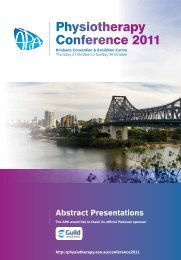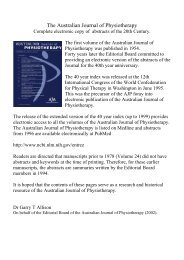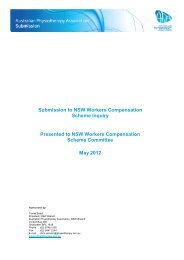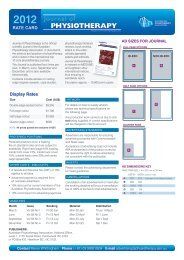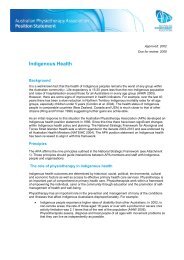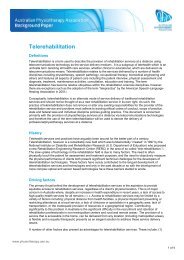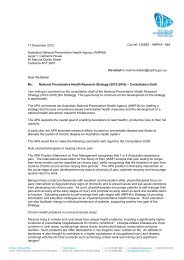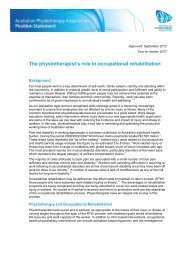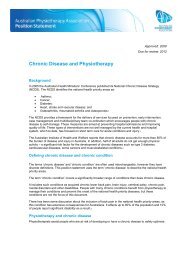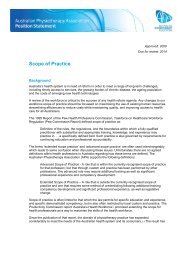2009 APA Conference Week Abstracts - Australian Physiotherapy ...
2009 APA Conference Week Abstracts - Australian Physiotherapy ...
2009 APA Conference Week Abstracts - Australian Physiotherapy ...
Create successful ePaper yourself
Turn your PDF publications into a flip-book with our unique Google optimized e-Paper software.
Cardiorespiratory <strong>Physiotherapy</strong> Australia<br />
Why is positive expiratory pressure physiotherapy<br />
used in children with cystic fibrosis under three years<br />
of age?<br />
Wilson CJ, Wright SE, Wainwright CE, on behalf of the<br />
Australasian Cystic Fibrosis Bronchoalveolar Lavage<br />
(ACFBAL) study<br />
Royal Children’s Hospital, Brisbane<br />
Positive Expiratory Pressure (PEP) physiotherapy is an<br />
option for airway clearance in cystic fibrosis (CF). PEP<br />
theory suggests volume change via collateral ventilation,<br />
and a secondary mechanism of airway stabilisation. PEP is<br />
typically introduced in CF around school commencement.<br />
The ACFBAL study physiotherapy protocol utilised<br />
positioning, chest percussion, and age-appropriate activity<br />
from infant diagnosis, with subsequent treatment changes<br />
made at the discretion of the physiotherapist. This<br />
prospective investigation reports PEP and clinical records<br />
when physiotherapy techniques were changed. Baseline,<br />
exacerbation, admission and routine reviews were analysed<br />
separately. PEP alone or used as an adjunct was compared<br />
to other techniques. 159 of 168 enrolled children (Mean<br />
age 3.6mths, SD 1.6) from 8 Australasian sites have three<br />
year data. 32 of 159 children (20%) used PEP before three<br />
years of age; three of these (9%) were diagnosed with<br />
significant tracheomalacia prior to commencing PEP. In<br />
PEP users, there was no association between barking or<br />
croupy coughs typically associated with tracheomalacia.<br />
Fort percent of the cohort had a cough (any description)<br />
compared with 72% of PEP users. The implications of this<br />
will be discussed Reasons for early initiation of PEP may<br />
include physiotherapist familiarity with PEP, the presence<br />
of persistent cough or unexpected bronchoscopy findings<br />
indicating a need to change the regimen. Our expectation<br />
that early use of PEP would be associated with barking or<br />
croupy cough; nocturnal cough, and/or malacia was not<br />
supported. Further systematic study of this emerging trend<br />
is warranted, particularly where airway malacia is identified<br />
in young children.<br />
The effects of pulmonary rehabilitation in the<br />
treatment of advanced cancer patients<br />
Zafiropoulos B, Jongs W, Glare P<br />
Sydney Cancer Centre Royal Prince Alfred Hospital, Sydney<br />
This study aimed to assess the effects of a multidisciplinary<br />
pulmonary rehabilitation approach in the treatment of<br />
advanced cancer patients. Patients were assessed by<br />
physician, dietician and physiotherapist and provided with<br />
symptom management, dietary intervention, and home<br />
or gym based exercise programs. Fifty-three patients<br />
(median age 62 years, mainly stage III and IV lung or<br />
gastrointestinal cancers) were referred to the program<br />
with 79% of these patients receiving anticancer therapies<br />
concomitantly. Baseline median and interquartile range<br />
(IQR) values for Karnofsky Performance Scores were<br />
70 (60–80), six-minute walk test distances were 442 m<br />
(382–521 m), and handgrip strengths were 69% (left) and<br />
74% (right) of predicted normal values. At baseline, 78%<br />
of the sample was moderately or severely malnourished as<br />
per the Patient Generated Subjective Global Assessment.<br />
Following 3 months in the program, six-minute walk test<br />
distance increased from baseline by 147 m (33%) to 589<br />
m (585 to 600 m) and handgrip strengths increased to<br />
82% (left) and 85% (right) of predicted values. Karnofsky<br />
Performance Scores remained stable with Edmonton<br />
Symptom Assessment System scores decreasing over time.<br />
Weight was observed to stabilise with decreases in Patient<br />
Generated Subjective Global Assessment scores indicating<br />
improvements in nutritional status. Although drop out<br />
rates were high, patients who remained in the program<br />
demonstrated improvements in nutritional status, endurance<br />
and strength, with decreases in cancer related symptoms.<br />
This multidisciplinary pulmonary rehabilitation approach<br />
is innovative and successful in providing supportive care<br />
for patients with advanced cancer.<br />
Prescribing walking training intensity from the sixminute<br />
walk test for people with chronic obstructive<br />
pulmonary disease<br />
Zainuldin R, 1 Mackey MG, 1 Alison JA 1,2<br />
1<br />
The University of Sydney, 2 Royal Prince Alfred Hospital, Sydney<br />
The six-minute walk test (6MWT) is often used to<br />
prescribe walking training intensity for people with chronic<br />
obstructive pulmonary disease (COPD). However, no<br />
research has investigated this training intensity in terms<br />
of oxygen consumption (VO2). The aim of this study was<br />
to examine whether the intensity of walking exercise<br />
prescribed from a 6MWT was within the recommended<br />
training range of 50–85% peak VO2. A prospective repeated<br />
measures study was conducted. Participants performed an<br />
incremental cycle test, and on a separate day two 6MWTs,<br />
each followed by 30 minutes rest and then 10 minutes of<br />
walking training at 80% of the average speed achieved in<br />
the better 6MWT. Each participant wore a rubber facemask<br />
connected to a lightweight portable gas analyser (Cosmed<br />
K4b2) worn on the chest with a harness. Breath-by-breath<br />
values of metabolic parameters were measured during each<br />
test and during walking training. Six participants walked<br />
a mean (SD) distance of 520(33)m and 694(44)m in the<br />
6MWT and the 10-minute walking training respectively.<br />
There was no significant difference between the peak VO2<br />
achieved in the cycle test and 6MWT (1356(255) ml/min<br />
and 1362(226) ml/min respectively). The VO2 from the<br />
10-minute walk training was 76(13)% of the peak VO2<br />
determined by the cycle test. Walking at 80% of the average<br />
speed of the 6MWT resulted in a training intensity within<br />
the recommended training range.<br />
The e-AJP Vol 55: 4, Supplement 27



